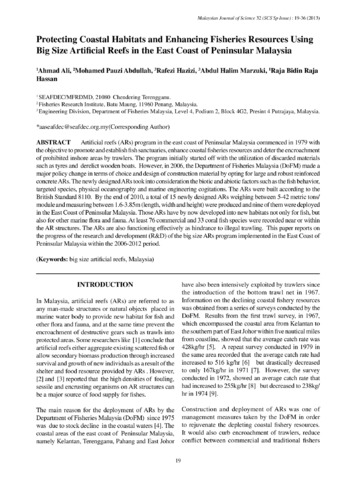Protecting coastal habitats and enhancing fisheries resources using big size artificial reefs in the east coast of peninsular Malaysia

Associated URL
ejournal.um.edu.myDate
2013Author
Page views
651Metadata
Show full item recordCited times in Scopus
Share
Abstract
Artificial reefs (ARs) program in the east coast of Peninsular Malaysia commenced in 1979 with the objective to promote and establish fish sanctuaries, enhance coastal fisheries resources and deter the encroachment of prohibited inshore areas by trawlers. The program initially started off with the utilization of discarded materials such as tyres and derelict wooden boats. However, in 2006, the Department of Fisheries Malaysia (DoFM) made a major policy change in terms of choice and design of construction material by opting for large and robust reinforced concrete ARs. The newly designed ARs took into consideration the biotic and abiotic factors such as the fish behavior, targeted species, physical oceanography and marine engineering cogitations. The ARs were built according to the British Standard 8110. By the end of 2010, a total of 15 newly designed ARs weighing between 5-42 metric tons/ module and measuring between 1.6-3.85m (length, width and height) were produced and nine of them were deployed in the East Coast of Peninsular Malaysia. Those ARs have by now developed into new habitats not only for fish, but also for other marine flora and fauna. At least 76 commercial and 33 coral fish species were recorded near or within the AR structures. The ARs are also functioning effectively as hindrance to illegal trawling. This paper reports on the progress of the research and development (R&D) of the big size ARs program implemented in the East Coast of Peninsular Malaysia within the 2006-2012 period.
Suggested Citation
Ali, A., Abdullah, M. P., Hazizi, R., Marzuki, A. H., & Raja Hassan, R. B. (2013). Protecting coastal habitats and enhancing fisheries resources using big size artificial reefs in the east coast of peninsular Malaysia. Malaysian Journal of Science , 32(3), 19-36. https://doi.org/10.22452/mjs.vol32no3.3
Subject
Collections
Related items
Showing items related by title, author, creator and subject.
-
Artificial Reefs Management and Development in Malaysia
Zainudin, Ahmad Zuwairi (Training Department, Southeast Asian Fisheries Development Center, 2016)Development of artificial reefs in Malaysia started since 1975 in Kedah. The 1st artificial reefs were made of used tyres. Advancements in technology allowed the development of artificial reefs using other ... -
Coral reef rehabilitation and restoration: Experience of Malaysia
Chan, Albert Apollo; Sukarno, W. (Training Department, Southeast Asian Fisheries Development Center, 2016)After the event of mass coral bleaching in 2010 and the ever vulnerability on the marine environment due to climate change, the Department of Marine Park Malaysia starts to look at ways to address the future of coral reefs ... -
Information Collection for Evaluation of Artificial Reefs
Ali, Ahmad; Isa, Mahyam Mohd. (Training Department, Southeast Asian Fisheries Development Center, 2005)The article presents efforts on information collection for the evaluation of artificial reefs in Malaysia.





